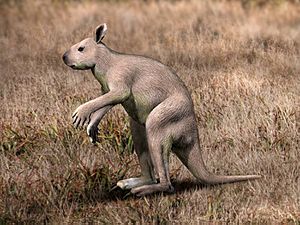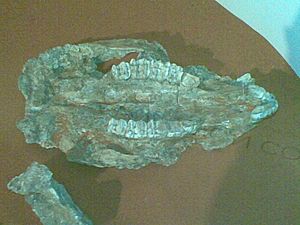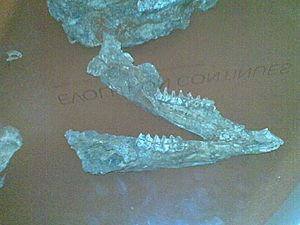Sthenurus facts for kids
Quick facts for kids Sthenurus |
|
|---|---|
 |
|
| A Sthenurus skeleton at the Museum of Victoria | |
| Scientific classification |
|
| Kingdom: | Animalia |
| Phylum: | Chordata |
| Class: | Mammalia |
| Infraclass: | Marsupialia |
| Order: | Diprotodontia |
| Suborder: | Macropodiformes |
| Family: | Macropodidae |
| Subfamily: | †Sthenurinae |
| Tribe: | †Sthenurini |
| Genus: | †Sthenurus (Owen, 1873a) |
| Paleospecies | |
|
|
Sthenurus (say: STHEN-yoo-rus) means "strong tail." It was a type of giant kangaroo that lived a long, long time ago. These amazing animals are now extinct, meaning they no longer exist. Some Sthenurus species were huge, growing up to 3 meters (10 feet) tall! That's twice as big as the kangaroos we see today. Sthenurus was related to another well-known extinct kangaroo called Procoptodon. Scientists believe these giant kangaroos first appeared during the Miocene epoch and became more common during the Pliocene epoch.
Contents
Where They Lived and What They Ate
Scientists have studied the bones of Sthenurus found in places like South Australia. They looked at tiny clues in the bones to figure out what these ancient kangaroos ate.
At older fossil sites, like Cooper Creek, Sthenurus mostly ate leaves and twigs. This was because the climate was wet, and there were lots of different plants. This was about 132,000 to 108,000 years ago.
Later, around 30,000 years ago, at a place called Baldina Creek, Sthenurus had changed its diet to mostly grass. At this time, Australia was much drier, with open grasslands and fewer trees. However, at other sites like Dempsey's Lake and Rockey River, they ate both grass and leaves. This might have been because those areas had wetter weather. Even though their diet changed, the basic body shape of Sthenurus stayed the same. Their teeth didn't really change to handle the different types of plants either.
Other ancient animals found in the same areas as Sthenurus include the giant flightless bird Genyornis, the red kangaroo, and the huge Diprotodon. Early humans also lived in some of these places.
Scientists also found Sthenurus bones at Lake Callabonna in South Australia. It seems these animals got stuck in the muddy clay while trying to cross the lake when the water was low. At this one lake, three different kinds of Sthenurus lived together: a very large one called S. stirlingi, a medium-sized one called S. tindalei, and a smaller one called S. andersoni.
Comparing Sthenurus bones to modern kangaroos like the Eastern grey kangaroo shows how different they were. Sthenurus had short, deep skulls, long front feet with tiny side toes, and only one big toe on their back feet.
Fossils of Sthenurus atlas, S. occidentalis, and S. newtonae have also been found in New South Wales, Australia.
How They Looked
Sthenurus had a tail that was shorter but much stronger than the tails of kangaroos today. Instead of three toes on each back foot like a red kangaroo, they had only one toe. This single toe was their fourth toe, and it had a small, hoof-like nail. This was perfect for walking on flat ground.
Their bones were very strong, and they had powerful back legs. They also had a wide pelvis (hip bones), a short neck, and longer arms and fingers than modern kangaroos. Their long fingers might have helped them grab stems and twigs while eating. These special body parts helped them eat leaves and twigs, though some species likely ate grass.
The biggest Sthenurus species could weigh around 240 kilograms (530 pounds). That's almost three times heavier than the largest kangaroos alive today! Because they were so big and heavy, the largest Sthenurus probably didn't hop like modern kangaroos. Instead, they likely walked on two legs, similar to how humans walk. Hopping slowly would have been very hard for such a massive animal.
Sthenurus also had a short, deep skull. This shape gave them stereoscopic vision, which means they had good depth perception, helping them see how far away things were.
Their Skull and Teeth
The skull of S. stirlingi was long and had a higher braincase and a swollen nose area compared to S. tindelai. S. andersoni had a unique dome-shaped forehead.
Their teeth were tough and covered in strong enamel. This made them good for chewing tough plants. The way their teeth were shaped also suggests that Sthenurus and modern kangaroos might have come from a common ancestor.
Sthenurus and Early Humans
Evidence from a place called Cuddie Springs shows that Native Australians lived in the same areas as Sthenurus and other large animals. Scientists found stone tools at this site that were used for cutting meat, but not many tools that seemed designed for hunting large animals. Wooden hunting tools like boomerangs and spears might have been used but didn't survive.
While some people think that humans might have caused the extinction of these giant animals, many studies suggest that the extinction of Sthenurus was probably already happening because of big changes in the climate. Since Sthenurus were plant-eaters, they struggled when their food sources changed due to the drier climate. This likely had a much bigger impact on their survival than human contact.
Images for kids
See also
 In Spanish: Sthenurus para niños
In Spanish: Sthenurus para niños










